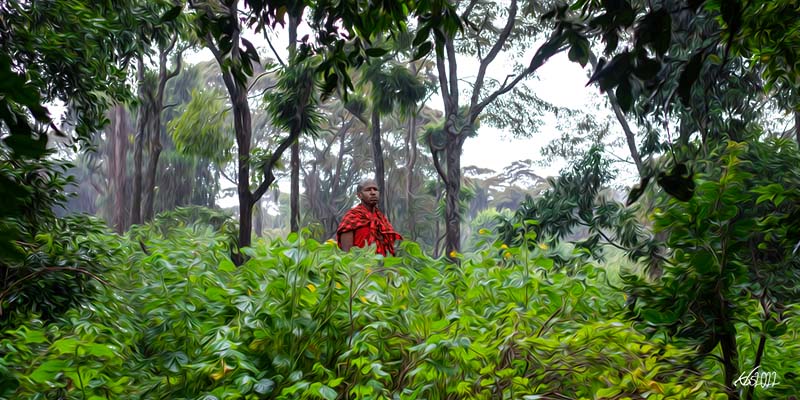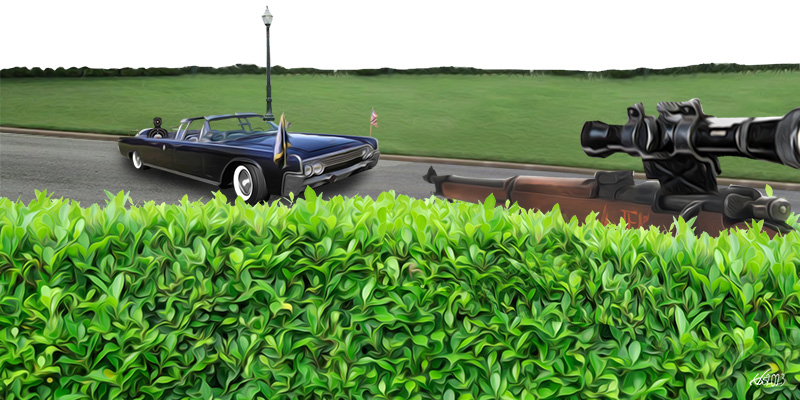The Sekenani River underwent a mammoth cleanup in May 2020, undertaken by over 100 women living in the Nashulai Conservancy area. Ten of the 18 kilometres of fresh water were cleaned of plastic waste, clothing, organic material and other rubbish that presented a real threat to the health of this life source for the community and wildlife. The river forms part of the Mara Basin and goes on to flow into Lake Victoria, which in turn feeds the River Nile.
The initiative was spearheaded by the Nashulai Conservancy — the first community-owned conservancy in the Maasai Mara that was founded in 2015 — which also provided a daily stipend to all participants and introduced them to better waste management and regeneration practices. After the cleanup, bamboo trees were planted along the banks of the river to curb soil erosion.
You could call it a classic case of “nature healing” that only the forced stillness caused by a global pandemic could bring about. Livelihoods dependent on tourism and raising cattle had all but come to a standstill and people now had the time to ponder how unpredictable life can be.
“I worry that when tourism picks up again many people will forget about all the conservation efforts of the past year,” says project officer Evelyn Kamau. “That’s why we put a focus on working with the youth in the community on the various projects and education. They’ll be the key to continuation.”
Continuation in the broader sense is what Nashulai and several other community-focused projects in Kenya are working towards — a shift away from conservation practices that push indigenous people further and further out of their homelands for profit in the name of protecting and celebrating the very nature for which these communities have provided stewardship over generations.
A reckoning
Given the past year’s global and regional conversations about racial injustice, and the pandemic that has left tourism everywhere on its knees, ordinary people in countries like Kenya have had the chance to learn, to speak out and to act on changes.
Players in the tourism industry in the country that have in the past privileged foreign visitors over Kenyans have been challenged. In mid-2020, a poorly worded social media post stating that a bucket-list boutique hotel in Nairobi was “now open to Kenyans” set off a backlash from fed-up Kenyans online.
The post referred to the easing of COVID-19 regulations that allowed the hotel to re-open to anyone already in the country. Although the hotel tried to undertake damage control, the harm was already done and the wounds reopened. Kenyans recounted stories of discrimination experienced at this particular hotel including multiple instances of the booking office responding to enquiries from Kenyan guests that rooms were fully booked, only for their European or American companions to call minutes later and miraculously find there were in fact vacancies. Many observed how rare it was to see non-white faces in the marketing of certain establishments, except in service roles.
Another conversation that has gained traction is the question of who is really benefiting from the conservation business and why the beneficiaries are generally not the local communities.
Kenyan conservationist and author Dr Mordecai Ogada has been vocal about this issue, both in his work and on social media, frequently calling out institutions and individuals who perpetuate the profit-driven system that has proven to be detrimental to local communities. In The Big Conservation Lie, his searing 2016 book co-authored with conservation journalist John Mbaria, Ogada observes, “The importance of wildlife to Kenya and the communities here has been reduced to the dollar value that foreign tourists will pay to see it.” Ogada details the use of coercion tactics to push communities to divide up or vacate their lands and abandon their identities and lifestyles for little more than donor subsidies that are not always paid in full or within the agreed time.
A colonial hangover
It is important to note that these attitudes, organizations and by extension the structure of safari tourism, did not spring up out of nowhere. At the origin of wildlife safaris on the savannahs of East Africa were the colonial-era hunting parties organised for European aristocracy and royalty and the odd American president or Hollywood actor.
Theodore Roosevelt’s year-long hunting expedition in 1909 resulted in over 500 animals being shot by his party in Kenya, the Democratic Republic of Congo and Sudan, many of which were taken back to be displayed at the Smithsonian Institute and in various other natural history museums across the US. Roosevelt later recounted his experiences in a book and a series of lectures, not without mentioning the “savage” native people he had encountered and expressing support for the European colonization project throughout Africa.
Much of this private entertaining was made possible through “gifts” of large parcels of Kenyan land by the colonial power to high-ranking military officials for their service in the other British colonies, without much regard as to the ancestral ownership of the confiscated lands.
At the origin of wildlife safaris on the savannahs of East Africa were the colonial-era hunting parties organised for European aristocracy and royalty.
On the foundation of national parks in the country by the colonial government in the 1940s, Ogada points out the similarities with the Yellowstone National Park, “which was created by violence and disenfranchisement, but is still used as a template for fortress conservation over a century later.” In the case of Kenya, just add trophy hunting to the original model.
Today, when it isn’t the descendants of those settlers who own and run the many private nature reserves in the country, it is a party with much economic or political power tying local communities down with unfair leases and sectioning them off from their ancestral land, harsh penalties being applied when they graze their cattle on the confiscated land.
This history must be acknowledged and the facts recognised so that the real work of establishing a sustainable future for the affected communities can begin. A future that does not disenfranchise entire communities and exclude them or leave their economies dangerously dependent on tourism.
The work it will take to achieve this in both the conservation and the wider travel industry involves everyone, from the service providers to the media to the very people deciding where and how to spend their tourism money and their time.
Here’s who’s doing the work
There are many who are leading initiatives that place local communities at the centre of their efforts to curb environmental degradation and to secure a future in which these communities are not excluded. Some, like Dr Ogada, spread the word about the holes in the model adopted by the global conservation industry. Others are training and educating tourism businesses in sustainable practices.
There are many who are leading initiatives that place local communities at the centre of their efforts to curb environmental degradation.
The Sustainable Travel and Tourism Agenda, or STTA, is a leading Kenyan-owned consultancy that works with tourism businesses and associations to provide training and strategies for sustainability in the sector in East Africa and beyond. Team leader Judy Kepher Gona expresses her optimism in the organization’s position as the local experts in the field, evidenced by the industry players’ uptake of the STTA’s training programmes and services to learn how best to manage their tourism businesses responsibly.
Gona notes, “Today there are almost 100 community-owned private conservancies in Kenya which has increased the inclusion of communities in conservation and in tourism” — which is a step in the right direction.
The community conservancy
Back to Nashulai, a strong example of a community-owned conservancy. Director and co-founder Nelson Ole Reiya who grew up in the area began to notice the rate at which Maasai communities around the Mara triangle were selling or leasing off their land and often their rights to live and work on it as they did before, becoming what he refers to as “conservation refugees”.
In 2016, Ole Reiya set out to bring together his community in an effort to eliminate poverty, regenerate the ecosystems and preserve the indigenous culture of the Maasai by employing a commons model on the 5,000 acres on which the conservancy sits. Families here could have sold their ancestral land and moved away, but they have instead come together and in a few short years have done away with the fencing separating their homesteads from the open savannah. They keep smaller herds of indigenous cattle and they have seen the return of wildlife such as zebras, giraffes and wildebeest to this part of their ancient migratory route. Elephants have returned to an old elephant nursery site.
In contrast to many other nature reserves and conservancies that offer employment to the locals as hotel staff, safari guides or dancers and singers, Nashulai’s way of empowering the community goes further to diversify the economy by providing skills and education to the residents, as well as preserving the culture by passing on knowledge about environmental awareness. This can be seen in the bee-keeping project that is producing honey for sale, the kitchen gardens outside the family homes, a ranger training programme and even a storytelling project to record and preserve all the knowledge and history passed down by the elders.
They keep smaller herds of indigenous cattle and they have seen the return of wildlife such as zebras, giraffes and wildebeest to this part of their ancient migratory route.
The conservancy only hires people from within the community for its various projects, and all plans must be submitted to a community liaison officer for discussion and a vote before any work can begin.
Tourism activities within the conservancy such as stays at Oldarpoi (the conservancy’s first tented camp; more are planned), game drives and day visits to the conservation and community projects are still an important part of the story. The revenue generated by tourists and the awareness created regarding this model of conservation are key in securing Nashulai’s future. Volunteer travellers are even welcomed to participate in the less technical projects such as tree planting and river clean-ups.
Expressing his hopes for a paradigm shift in the tourism industry, Ole Reiya stresses, “I would encourage visitors to go beyond the superficial and experience the nuances of a people beyond being seen as artefacts and naked children to be photographed, [but] rather as communities whose connection to the land and wildlife has been key to their survival over time.”








